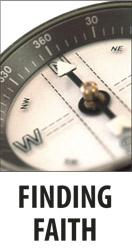

ROGERS — Parents and catechists are not the only ones trying to bridge the chasm between young adults and their faith in the modern world. A poll conducted by the Pew Research Center in May 2015 found more than one-third of millennials are unaffiliated with any faith.
“We’ve known that the religiously unaffiliated has been growing for decades,” said Greg Smith, lead researcher for the study of more than 35,000 Americans, “but the pace at which they have continued to grow is really astounding.”
When droves of individuals 16-29 years old are leaving the Church, it is time for a top-down approach.
That is why Pope Francis is reaching out and going digital in hopes of discovering more on this demographic. In the pope’s “preparatory document” released in January 2017, he describes the purpose of the Synod of Bishops on Young People, the Faith and Vocational Discernment is to “lead young people to recognize and accept the call to the fullness of life and love” and to help the Church “in identifying the most effective way to announce the Good News today.”
In June, the Vatican released an online survey for young people “to express themselves” and tell who they are and what they believe. In anticipation of the synod in Rome in October 2018, the pope aims to better understand the needs of this generation.
Young people around the globe can go on the website and in about 20 minutes answer questions, in their language of choice, which will help the pope and the Church at large to meet this generation “where they are” and to see where the Church’s younger congregants need ministering in the 21st century.
But as inclusive as this may sound, many will not participate because they have not heard of the survey or will not take the time. Yet, knowing some of the questions that are on the questionnaire could spark conversation in churches, youth groups or even around the dinner table.
In hopes of getting a representative sampling of answers, three of the questions from the survey were distributed to about 20 young people attending youth ministry one Sunday at St. Vincent de Paul Church in Rogers.
Not surprisingly, most answered “Who is Jesus to you?” with “the Savior,” “a prophet,” “ a model to imitate” and a “trusted friend.”
But, interestingly, the second question which asked respondents to rate the importance of different activities of the Church, delivered some answers that might surprise a few. Less than half of the respondents thought catechesis was an important aspect of the Church. But, most of the respondents felt the activity of youth associations was very important.
That sentiment was reiterated in the following question when respondents were asked to briefly tell of an episode that was a positive example of how the Church could accompany young people in making choices that give fullness to their lives.
Students talked about youth directors that had “amazing connections” with the youth and how “small groups in high school helped mold their faith.”
Another cited how “it meant a lot to me to have adult males who cared,” when speaking of their youth group leaders. Volunteers and youth leaders who “were welcoming,” “supportive” and “encouraging” were the descriptions used for the individuals who made a difference for these teens.
What was striking was the overwhelming consensus believing in the importance of youth ministry and faithful young adults who volunteered their time to be present and listen to the teens.
Next year, it will be interesting to see what the Synod’s findings will be following the survey of youth around the world. But, these answers are likely reflective of what other young adults may be feeling in an age of disconnected technology: the need to personally connect.
These questions and others can be found at youth.synod2018.va.
Please read our Comments Policy before posting.
Article comments powered by Disqus More pastoral appointments announced
More pastoral appointments announced
 Most U.S. Catholics approve of Pope Francis, Pew says
Most U.S. Catholics approve of Pope Francis, Pew says
 Pope asks Christ to 'roll away' the stones of war
Pope asks Christ to 'roll away' the stones of war
 'Why, Lord?' appropriate prayer in grief, Pope says
'Why, Lord?' appropriate prayer in grief, Pope says
 Fort Smith church raising $2.5 million for security
Fort Smith church raising $2.5 million for security
 MSM senior an all-around winner in classroom and track
MSM senior an all-around winner in classroom and track
 Mount St. Mary alum rallied community after wreck
Mount St. Mary alum rallied community after wreck
 Deacon served in two Central Arkansas parishes
Deacon served in two Central Arkansas parishes
 Catholic Answers receives backlash for its AI priest
Catholic Answers receives backlash for its AI priest
 I knew in fifth grade Jesus was my best friend
I knew in fifth grade Jesus was my best friend
 St. Joseph a model of solidarity with immigrants
St. Joseph a model of solidarity with immigrants
 Two gifts after Jesus’ death: Virgin Mary and Eucharist
Two gifts after Jesus’ death: Virgin Mary and Eucharist
 Why we have an altar, and not just a communion table
Why we have an altar, and not just a communion table
 Pope: Wars should be resolved through nonviolence
Pope: Wars should be resolved through nonviolence